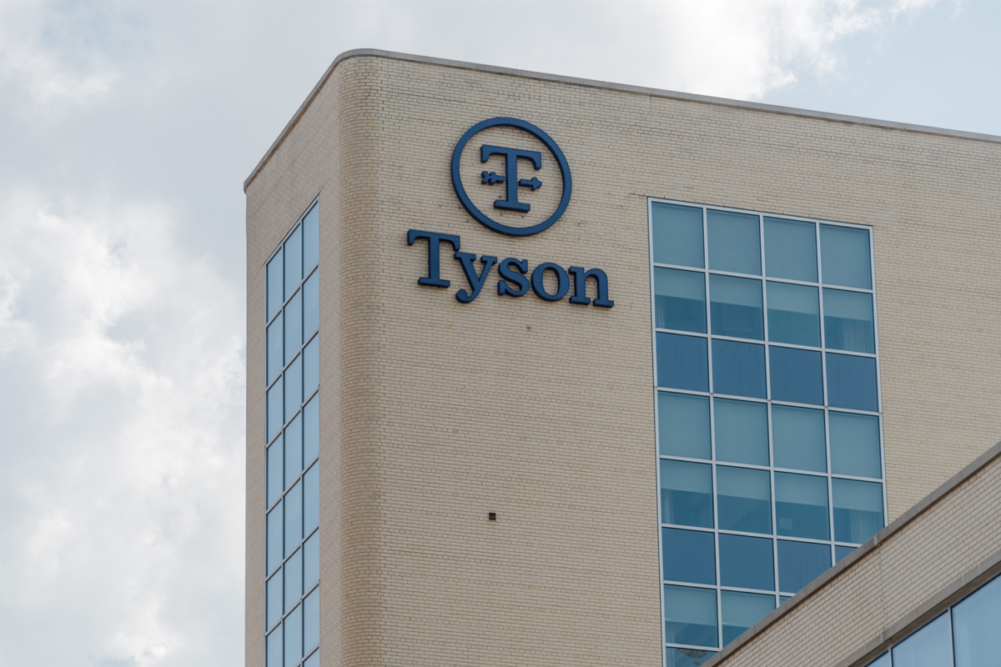SPRINGDALE, ARK. — Executives of Tyson Foods, Inc. pointed to higher prices implemented in response to rising input costs as one tactic the company used to increase earnings in the first quarter ended Jan. 2. Vaccine mandates played a factor as well and should continue to help Tyson tackle a labor shortage in the current fiscal year.
Tyson Foods in the quarter achieved net income of $1.13 billion, or $3.16 per share on the common stock, which compared with $472 million, or $1.31 per share, in the previous year’s first quarter. Net sales jumped 24% to $12.93 billion from $10.46 billion.
Tyson’s stock on the New York Stock Exchange closed at $99.09 per share on Monday, Feb. 7, the day financial results were announced. It was a 12% increase from a close of $88.29 on Friday, Feb. 4.
“In the quarter, our cost of goods sold was up 18% relative to the same period last year,” said Donnie King, president and chief executive officer, in a Feb. 7 earnings call. “We are seeing higher costs across our supply chain, including higher input costs, such as feed and ingredients. We're also managing higher cost of labor, transportation due to strong demand and limited availability.
“With these higher costs, we work closely with our customers to achieve a fair value for our products. As a result, our average sales price for the quarter increased 19.6% relative to the same period last year. This helped us capture some of the unrecovered costs due to the timing lag between inflation and price.”
The Springdale-based company in August announced it was requiring all employees in the United States to have COVID-19 vaccinations. Exemptions were made for workers who sought medical or religious accommodation.
“We think our vaccine mandate served us well, and making that commitment and really making our team members' health and safety and their families and communities our highest priority has served us through the new variant,” Mr. King said. “We've seen better absenteeism and turnover throughout the organization. We think labor will be much greater in the balance of the year.”
The new variant, omicron, spiked in the first three weeks of January, he said, but labor challenges still are impacting Tyson volumes and customer demand continues to outpace the company’s ability to supply products. Mr. King pointed to immigrants from different parts of the world belonging to Tyson’s workforce and how the company is seeking Afghan refugees as workers.
“We tried to be available with — and working with — the government in terms of having availability, and we've worked with communities in terms of trying to build or to find housing to support that, to make it easier,” Mr. King said.
In the first quarter net sales rose in four of Tyson’s business segments.
In Beef, operating income of $956 million was up 81% from $528 million in the previous year’s first quarter. Sales rose 25% to $5 billion from $3.99 billion. Strong demand for beef products supported higher average sales price, said Stewart F. Glendinning, chief financial officer for Tyson, adding higher cattle costs partially offset the higher price. Sales volumes decreased because of the labor environment and supply chain constraints.
In Pork, operating income of $164 million was up 41% from $116 million in the previous year’s first quarter. Sales increased 13% to $1.63 billion from $1.44 billion behind an average sales price increase of nearly 13%. Sales volume rose slightly as strong global demand was offset by the impacts associated with the labor environment.
In Chicken, operating income of $140 million compared to an operating loss of $216 million in the previous year’s first quarter. Sales rose 37% to $3.89 billion from $2.83 billion. Sales volume increased primarily because of increased live production and strong demand.
“Our teams have been focused on streamlining our plants to deliver higher volumes, and we expect to deliver substantial volume improvements in fiscal 2022 as hatch recovers and we continue to look for ways to operate our plant more efficiently,” Mr. Glendinning said.
In Prepared Foods, operating income of $186 million was down 30% from $266 million. Pricing actions were not enough to fully offset increases in raw material and other input costs. Sales of $2.33 billion were up 10% from $2.11 billion. Sales volume decreased after Tyson divested its pet treat business in the previous fiscal year’s fourth quarter.
